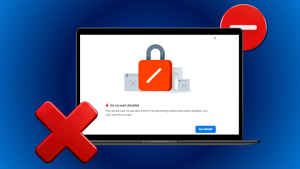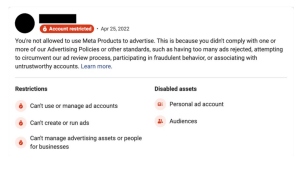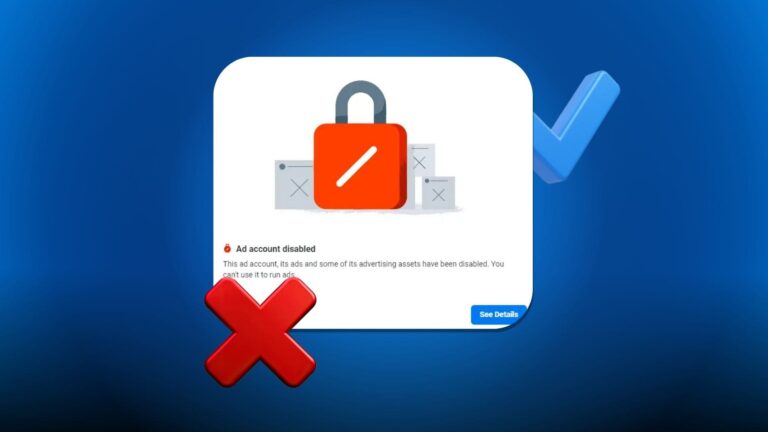If your Facebook ad account disabled, you’re not alone. In 2025, Meta’s enforcement has become even more automated and aggressive — sometimes banning accounts without clear reasons. For businesses, media buyers, and agencies, this can mean halted campaigns, lost revenue, and a scramble for recovery.
In this guide, we’ll walk you through why ad accounts get disabled, how to appeal effectively, and most importantly — how to prevent it from happening again.

Why Is Your Facebook Ad Account Disabled?
When your Facebook ad account is disabled, the platform believes you’ve violated one or more of its advertising policies. These violations fall under two main categories:
1. Policy Violations
The most common reason a Facebook ad account is disabled is a violation of Meta’s advertising policies. This may include:
- Misleading or exaggerated ad claims. If your ads promise unrealistic results or use hype-heavy language, they could be flagged.
- Landing pages that don’t match the ad. For example, advertising a free eBook but leading users to a sales page.
- Prohibited content. This includes restricted verticals like health, finance, or adult content if not framed properly.
- Use of personal attributes. Phrases like “Are you struggling with debt?” are flagged for assuming personal conditions.
2. Suspicious Behavior
Apart from content violations, suspicious activity can also lead to account bans:
- New account spending aggressively. A brand-new ad account that suddenly spends thousands may trigger automatic review.
- Logins from different IPs and devices. Facebook sees this as potential account takeover or fraud.
- Cloaking, VPNs, or automation tools. These create trust issues with the platform.
- Frequent ad rejections. If multiple ads get disapproved in a short time, it can lead to automated disabling.
Often, Facebook doesn’t provide a detailed reason — just a vague message like “Account disabled for violating advertising policies.”
 Step 1: Review the Notification in Account Quality Center
Step 1: Review the Notification in Account Quality Center
The first step after seeing “Facebook ad account disabled” is to visit the Account Quality section in your Business Manager.
There, examine the status of your assets and look for:
- Specific ad disapprovals. Check which ads were flagged and why.
- Warnings or previous violations. A history of minor issues may lead to a larger penalty.
- Reason for the restriction. Sometimes a brief explanation will be listed.
Understanding whether the issue was isolated or part of a larger pattern will guide your next move.
Step 2: Submit an Appeal the Right Way
Don’t panic. While appeals don’t always succeed, submitting a clear, well-reasoned one gives you the best shot when your Facebook ad account is disabled.
2.1 Be Professional and Specific
When you submit the appeal:
- Acknowledge Meta’s policies. Show that you understand what went wrong.
- Explain the situation. Clarify why you believe the action was taken in error.
- Describe your corrective steps. Mention any changes you’ve made since the restriction.
Support your appeal with:
- Screenshots of your compliant ads. Prove your creatives followed policy.
- A link to your landing page. Ensure the page is functional and matches the ad.
- A list of edits. Note any wording or formatting changes made to align with guidelines.
Maintain a respectful tone throughout. Avoid accusing Meta or using emotional language.
2.2 Use the Right Channels
Facebook offers different ways to file appeals:
- In-platform appeal. Usually found directly in Account Quality.
- Live chat support. If your account spends enough, chat access may be available.
- Meta Pro or Commerce Support. These offer human assistance for larger advertisers or ecommerce sellers.
Start with the native tools, and escalate only if necessary.
Step 3: Prepare Backup Infrastructure In Case Your Facebook Ad Account Is Disabled For A Long Time And Isn’t Reinstated
Don’t wait idly while the appeal is pending. Prepare a contingency plan in case the account isn’t restored.
- Create a second Business Manager. Ensure it’s established with clean data and not tied to flagged users.
- Secure a backup verified domain. Domains with strong reputations help avoid future flags.
- Set up a new Facebook page. Populate it with organic content and engagement.
- Build compliant creatives. Begin crafting new ad sets that clearly meet policy standards.
Avoid risky tactics like cloaking or fake engagement. These may work short-term, but severely damage your trust score.
Step 4: Learn and Avoid Future Disables
Use the experience as a lesson to reinforce long-term compliance.
4.1 Warm Up Properly
After noticing that your Facebook ad account is disabled, some advertisers rush to open a new one and allocate a substantial budget to regain lost momentum quickly. However, this approach can be counterproductive, often leading to additional bans or restrictions.
Always start new ad accounts with modest budgets. Gradually increase your ad spend over time to build trust and avoid triggering Facebook’s fraud detection systems. Meta’s algorithms closely monitor new accounts, and sudden spikes in spending on fresh accounts are often flagged as suspicious.
By warming up your new account steadily, you not only reduce the chances of another ban but also establish a foundation for safer and more sustainable advertising. This deliberate approach is key to ensuring your campaigns continue running smoothly and without further interruptions.
4.2 Stay Policy-Compliant
Revisit Meta’s ad policies regularly. Pay close attention to:
- Ad tone and language. Avoid exaggeration, urgency, or emotional manipulation.
- Consistency. Ensure the message and offer are aligned from ad to landing page.
- Banned terms. Phrases like “fastest results” or “guaranteed income” are commonly flagged.
4.3 Monitor Account Behavior
Account hygiene is key. Watch out for:
- Admin logins from unusual IPs. Use secured, consistent access.
- Shared payment methods. Keep billing methods unique to each Business Manager.
- Suspicious activity. Anything from bulk edits to tool usage should be managed cautiously.
If possible, manage ad accounts through a consistent, documented process.
Step 5: If You Lose the Appeal
Sometimes, even a strong appeal won’t result in reinstatement. Here’s what you can do next:
- Launch from your backup Business Manager. Use the new structure to rebuild safely.
- Change your approach. Test new creatives, funnels, or messaging strategies.
- Leverage trusted partners. Agencies with long-standing accounts may offer white-label ad solutions.
Never reuse ad copy, creatives, or domains directly from the disabled account. Instead, adjust your infrastructure to reduce risk.
Final Thoughts: When Your Facebook Ad Account is Disabled
When your Facebook ad account is disabled, it can feel like a major setback — campaigns stop, leads dry up, and momentum is lost. But this situation isn’t final. With the right recovery process, a proactive strategy, and smarter infrastructure, you can get back on track.
This is an opportunity to:
- Treat your Business Manager like an asset. Keep it clean, trusted, and stable.
- Align all parts of your ad ecosystem. Ads, pages, and funnels must match and follow policy.
- Commit to long-term stability. Avoid shortcuts. Focus on sustainable compliance and growth.
Want Guidance or Support?
We’ve been through it too. Join our Telegram group to connect with others, get real-time updates, and access free recovery tips and compliant ad strategies.



